Review: Nex Playground
As I’m coming up on a full year of “ownership,” and with it being more topical this holiday season (e.g. 2nd best-selling console this past Black Friday), let’s talk about the Nex Playground.

Essentially, the Nex is a motion-controlled game console with an all-in-one subscription model. Think Kinnect or Wii Sports, minus the controllers. For $250 retail price, you get the Nex cube, a remote, and permanent access to five party-style games. The “real” experience requires a further purchase of a 12-month Play Pass for $89, or the 3-month Play Pass for an usurious $49. At the time of this writing, there are bundles on Amazon that include the Nex and a 12-month pass for as low as $288.
Is it worth it?
Well… do you have kids as of yet unsullied by Fortnite, Minecraft, and/or Youtube? Then: probably.
I’ll go into more detail on the games below, but it is important to reiterate that the Nex is a motion-controlled device. Not all the games require you to be standing, squatting, and/or jumping, but you will nevertheless be using your arms 100% of the time at a minimum. Even if you or your kids are physically active, this is not something you will likely be playing for 1-2 hours at a time. If your immediate thought after reading that was “well, no one should be sitting/playing videogames for that long anyway,” then, yeah, the Nex is probably for you.
Base Games
Without the Play Pass, you are limited to these five games:
- Fruit Ninja
- Whac-a-Mole
- Go Keeper
- Party Fowl
- Starri
The first three are basically “arcade” style games that may or may not amuse you or children for a length of time. Party Fowl is a sort of goofy Mario Party knock-off filled with 90-second minigames. An example would be squatting to empty a helicopter bucket full of water onto gingerbread men running around on fire. Or shaking up virtual pop bottles and spraying them at the other person.
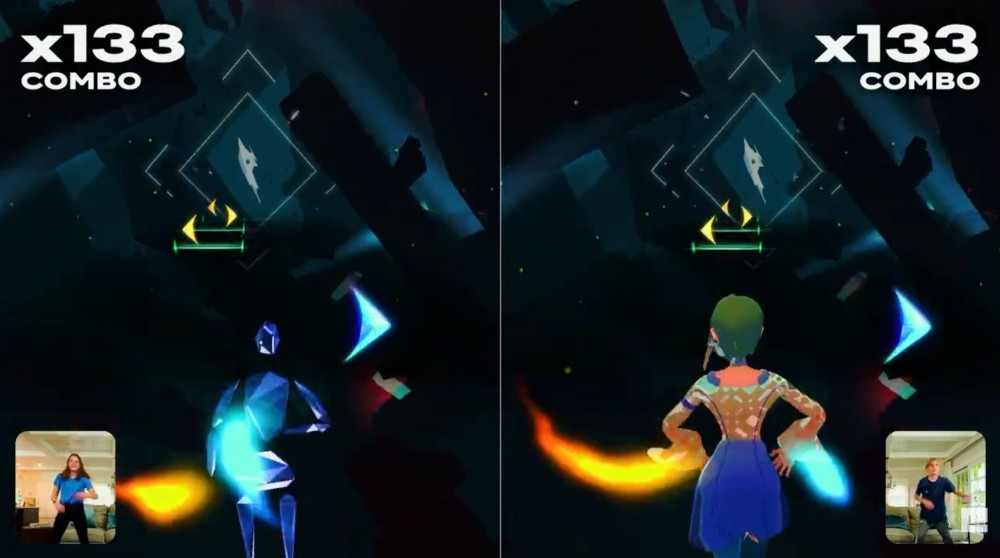
One of the killer apps for the Nex system though is Starri. This is a rhythm game akin to a VR-less Beat Saber, or perhaps an arms-based Dance Dance Revolution. There is an eclectic mix of songs, including several ones from Imagine Dragons, some Lady Gaga, Sia, and other contemporary artists. Last year, there were also a large amount of K-pop, but many of those rotated out; there still are a lot of anime songs. Regardless, Starri feels like a full-fledged game, with each song having three difficulty levels, in-game cosmetic unlocks, two different hand “game styles,” and so on.
Of all the games available, Starri stands out as something an adult could play solo and enjoy long-term.
Play Pass Games
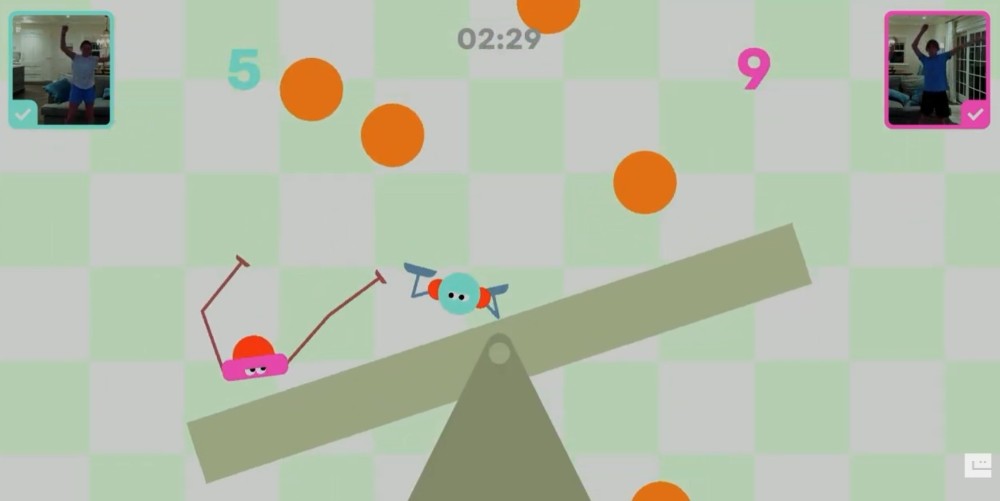
Tumbo Bots is one of the best-designed games on the system, hands down (or up). Basically, it’s a 1v1 battle game where you try to score points by hitting the red button on the other player’s head, and/or collecting coins if they’re available on the map. There’s also a soccer mode. What makes it fun are how your arms controls the legs of the bots, which requires you to swing them wildly about. QWOP-style, in order to move and jump. There is a large variety of maps and characters, and Little Man has gotten quite good at beating me even if I don’t totally sandbag my play (… but I still sandbag a bit).
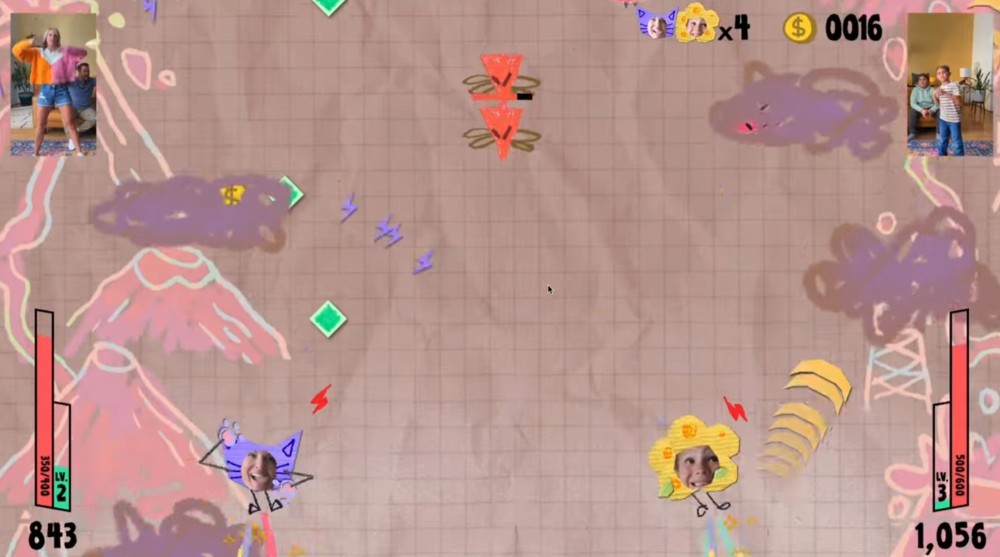
Doodle Heads is another favorite, to a slightly lesser degree. It’s kind of a Galaga-style game if children drew all the sprites, but it does feature four different heroes and six bosses across 12 levels. Just be prepared to be waving your hands above your head the entire time, as that is how you shoot.
…and that’s primarily it.
In reality, there are 40 other games within the Play Pass, but not all of them are especially good. Or fun. For example, there is Teenage Mutant Ninja Turtles: Rooftop Mayhem, which is essentially a side-scrolling Temple Run. Does anyone remember Temple Run? Basically where you’re in a fixed perspective going along a track while avoiding obstacles? Little Man played TMNT for like an hour one day, but I doubt he ever goes back. And there are three more licensed games in exactly that same style: Miraculous Ladybug: Paris Dash; Care Bears: Rainbow Ride; Candy Land: Sugar Sprint. A waste, IMO.
The other licensed content isn’t as bad. Kung Fu Panda, How to Train Your Dragon, and Cookie Monster have all went different directions. The problem I have with many of these other ones though is what I consider missteps with the property. For example, the Kung Fu Panda game is about training by hitting logs, chopping wood planks, and so on. Good. All of this gameplay is only available after long, unnecessary (and unskippable) exposition by knockoff voice actors. Very bad.
This is actually a more general weakness with many of the games wherein there are a lot of clunky menus and “plot” when you just want to be throwing hands and legs as soon as possible. Or when there are menus upon menus for games for which the core audience may not be able to read yet. I’m looking at you, Cookie Monster.
Final Thoughts
Whether a Nex is a good addition to your home comes down to your projected use-case.
If you are buying a Nex because “it’s cheaper than a Switch 2,” then you’re probably in a for a bad time. The current Amazon sale price of $288 includes a year of the Play Pass, which is good value… compared to the standard price of $250 + $89. But even on sale, the best-case scenario – in which your kids are totally happy playing with just the Nex – is that you’re still on the hook for another $89 Year 2. That’s now $377. Still technically cheaper, but they pretty much got you stuck.
And, really, what are the odds that your kids aren’t going to what to play Mario Kart (etc)?
If instead you treat the Nex as (slightly) guilt-free form of screentime exercise for the kids, and potentially for the whole family? That’s another story. Obviously you can do comparable movement things with Switch Sports and the like, but it may mitigate drama to have an entirely separate ecosystem wherein Minecraft, Mario Kart, or whatever else isn’t staring them in the face. Indeed, in our house, we don’t really even call the Nex “videogames” – it’s just something we do when the weather is too bad to go outside and we need to burn some energy.
Of All Time
I was browsing a Reddit thread called “We haven’t seen a good space opera game where you play a spaceship commander with a loyal crew since 2012”. The image in the post was for Mass Effect 3, to remove any doubt of to what space opera they were referring. Quite a few people pointed out that, in fact, the Outer Worlds series has been released since then. Amongst the pushback that the Outer Worlds is even remotely close to Mass Effect quality, was this rejoinder:
It’s easy to forget that many people here are young kids who only know things that came out this year.
That’s why you constantly hear about <insert aggressively average game here> being “the greatest of all time”, because for them “all time” is like 3 years.
It’s funny to imagine being a part of a cadre of human beings for which it’s somewhat possible to have a comprehensive experience on a matter. Like, if you were to ask what is the greatest adventure novel of all time, you would have literally a thousand years of human written storytelling to go through. Conversely, the first videogame RPG came out in 1980, depending on your definition of RPG. Even if you limit it to “classical” console-style RPGs, that moves the needle to 1986 with Dragon Quest.
My own personal experience with videogames started in the late NES era, and only really kicked off in the halcyon Squaresoft/SNES days of the mid-90s. Although, even then, there were gaps. For example, I never played Final Fantasy 4. Indeed, I tried playing it a few times in the last decade or so, and couldn’t really bring myself to get particularly far. Which shouldn’t be too surprising considering how few modern videogames (that I even paid for!) I complete on average.
And that sort of brings me back to the quote. Obviously young people exist – I hear their distinct cries of “six SEVEN” down the road all the time. And there is always a conversation surrounding whether old games hold up to modern play, even by the people who profess their greatest of all time status. But it nevertheless feels… tragic? Is that an appropriate word? It feels tragic to imagine a young person’s entire view of quality being limited to such a small time horizon.
That is, of course, how everything works. Has always worked. “GOAT” has always had asterisks galore, even (or especially) if denied. Greatest (in my subjective opinion) of All (that I’m aware of) Time (up to this moment). GIMSOOATIAOTUTTM just didn’t have the same ring to it though.
P.S. This makes me officially old, doesn’t it?
P.P.S. I already had an Officially Old tag from two years ago?! I’m actively turning to dust right now.
Sorta Black Friday, 2025 Edition
I started writing a list of games I had an eye on at the start of the holidays, and it has since passed me by with nary a thing purchased. At least, not from this list. Regardless, here it is for posterity:
- Dragon’s Dogma 2 – $22.07 (GameBillet)
- Dying Light 2 Reloaded Edition – $19.79 (Fanatical)
- God of War – $17.59 (GameBillet)
- Sekiro: Shadows Die Twice GOTY Edition – $29.99 (Steam)
- Ghost of Tsushima Director’s Cut – $31.75 (GameBillet)
- Horizon: Forbidden West Complete Edition – $32.35 (GameBillet)
- Kingdom Come: Deliverance 2 – $32.99 (AllYouPlay)
- Last of Us Part 2 Remastered – $33.98 (GameBillet)
On reflection, it’s pretty much just a list of every mainstream game released in the last 5 years. My actual wishlist is longer, but I sometimes forget that Steam doesn’t consider Black Friday to be a real holiday – most everything was not on sale, as it would normally be during the Winter Sale, for example.

What I did end up ordering this “holiday” season were technically two more Switch accessories. First was the 8Bitdo Lite 2 controller ($21), as a smaller controller for the Little Man. The normal Switch joy-cons sorta work for his hands already – using just one when playing Mario Kart 8, for example – but honestly I don’t like them all that much. If I want him to get more coordinated and better at videogames, getting used to a somewhat more “real” controller makes more sense. Plus, worst-case scenario, the controller itself works on Android devices.
The second item is the GameSir G8 Plus ($49 AliExpress), which is a telescoping bluetooth controller. While it can work with phones and even smaller tablets, the primary use-case is the Switch itself. There was a cheaper, Switch-specific option available, but again, I’m all about accounting for worst-case scenarios. To date, I have not played the Switch outside of Little Man co-op sessions in the living room, which means no Breath of the Wild (etc). If I’m being honest, I do not anticipate this purchase immediately solving that issue, but at least it eases some of the (future) potential friction.
Aside from all that, I am just continuing to quietly play Guild Wars 2 and Outer Worlds 2. Once the latter is finished, my plan is to move onto the last (hopefully) 10% of Final Fantasy 7 Rebirth, so as to free up 154 GB of space. After that… who knows. Baldur’s Gate 3 is right there. Death Stranding, too. Red Dead Redemption 2 as well. Or, you know, all of those Switch games I was talking about earlier.
Oh, or maybe Expedition 33! It is on Game Pass already…
Blowing Off Steam (Machine)
We have all the details about Valve’s new PConsole except the only thing that really matters: price.
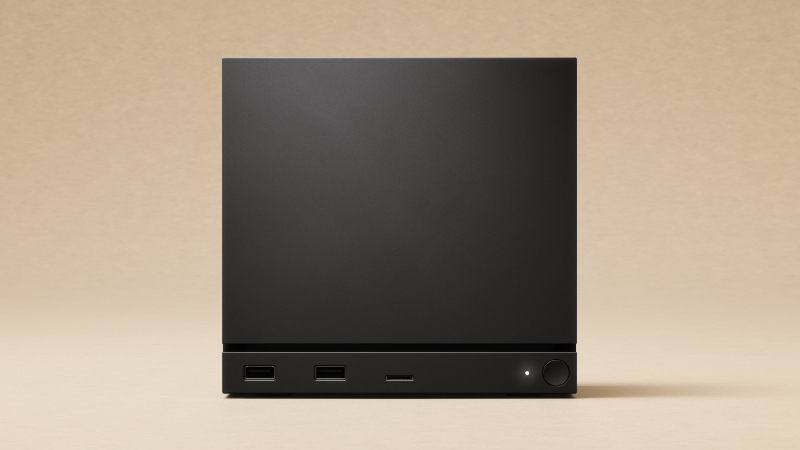
There are a lot of reasons why Valve might be slow-rolling that particular detail. For one thing, the amount of free press being generated by endless videos and news articles (and blog posts, oops) is enormous. Ten thousand TF2 hats off to the Valve marketing department. Or perhaps it’s like a trial balloon to gauge consumer interest at various price-points. Or maybe the answer is dead-ass simple: because nobody knows what prices for components will look like more than two days in advance, let alone a few months from now. RAM prices have almost doubled in the last two months. It certainly wouldn’t be a good look for any company to raise the price of a console three times in a year.
The whole conversation about whether Valve is really trying to squeeze into the console market and compete with Sony and Microsoft is kinda immaterial, IMO. The given specs are not particularly competitive with a PS5, nor is it well positioned to even really play any of the AAA games that drive the majority of consumer spending in the console space. Right now, games like Fortnite, CoD, GTA Online, and similar won’t play at all due to (Linux) incompatibility with anti-cheat software.
What Valve is actually doing is pretty straight-forward: creating a PConsole that is equal to/an upgrade of what 70% of Steam users currently have. And technically 6x more powerful than the Steam Deck.
But they also have a chance to break into the coveted Azuriel market… if they stick the price landing.
See, I’ve talked about it before, but I have a very specific use-case that is not currently being addressed in the market: introducing my kiddo to Minecraft in the living room. We technically have a Switch, which technically can have Minecraft on it, but the reviews have said it sucks on a technical level. Sluggish, buggy, and local co-op is just about unplayable. Meanwhile, I have a perfect PC rig a few rooms down. Up to this point, I had been contemplating rearranging my computer room into a side-by-side setup and going from there, but there’s a lot to like about a potential all-in-one GabeCube solution. Not the least of which is how many hundreds of other games I could share with the little man.
…unless the Steam Machine costs like fucking $800 or something. That would be enormously dumb.
I have dabbled in the burgeoning handheld emulator space, and the ever-present elephant in the room was the Steam Deck. “Is this $250 handheld worth it… or should I just buy a Steam Deck for a few hundred more?” To be clear, there are a lot of reasons why you may not want a Steam Deck. For instance, it’s very large. If all you care about is N64 games, getting something that can (technically) run Cyberpunk 2077 is overkill. But what Valve (unintentionally?) did was create a universal, $400 anchor in the handheld space. And, yeah, the top-tier model retails for $650. However, imagine if the Steam Deck debuted at $650 for the lowest model. Would it have been as popular or been the reference point for this market? No.
So, we don’t know the price for the Steam Machine. We do know that it’s not going to be subsidized like consoles, and it’s going to be priced “like a PC” of similar specs. The reasoning is begrudgingly sound: it’s technically an open Linux PC. The PS3 was subsidized back in the day with the assumption Sony would make back the money in software sales, and yet the Air Force chained 1,760 of them together to build a supercomputer. Thus, outside of bulk discounts of materials, the Steam Machine is likely to cost roughly the same as off-the-shelf components. Which puts it high. Which puts it out of reach for my purposes.
The one positive that may result, regardless of price, is developer focus on their games being “Steam Machine compatible.” Which is somewhat silly to say, given that its already a PC. That said, we have seen an out-sized (compared with units sold) effort to make games playable on the Steam Deck. Part of that is pure marketing math – someone who already shelled out cash for a Steam Deck is likely focused on playing a bunch of games on it – and the other part is likely relief at having a discrete endpoint. A given PC owner could have any number of configurations, and nearly every permutation must be accounted for. Meanwhile, a Steam Machine is a Steam Machine. If it plays well on that, it probably plays well everywhere else. Although perhaps playing on a Steam Deck is good enough.
Which just might be the play, in my case, if the Steam Machine ends up double the price of the Deck.
Authentic Wirehead
Bhagpuss has a post out called “It’s Real if I Say It’s Real,” with a strong argument that while people say they desire authenticity in the face of (e.g.) AI-generated music, A) people often can’t tell the difference, and B) if you enjoyed it, what does it even matter?
It was the clearest, most positive advocacy of the wirehead future I’ve ever seen in the wild.
Now, speaking of clarity, Bhagpuss didn’t advocate for wirehead in the post. Not directly. I have no personal reason to believe Bhagpuss would agree with my characterization of his post in the first place. However. I do believe it is the natural result and consequence of accepting the two premises.
Premise one is that we have passed (and are perhaps far beyond) the point at which the average person can easily differentiate between AI-generated content and the “real thing.” Indeed, is there really anyone anywhere ready to argue the opposite? Linked in the Bhagpuss’ post was this survey showing 97% of respondents being unable to tell the difference between human-made and AI-generated music across three samples. ChatGPT 4.5 already passed the classical three-way Turing Test, being selected as the human 73% of the time. Imagine that other person the research subject was texting with, and being so resoundingly rejected as human.
Then again, perhaps the results should not be all that surprising. We are very susceptible to suggestion, subterfuge, misdirection, and marketing. Bhagpuss brought up the old-school Pepsi vs Coke challenge, but you can also look at wine tasting studies where simply being told one type was more expensive led to it being rated more highly. Hell, the simple existence of the placebo effect at all should throw cold (triple-filtered, premium Icelandic) water on the notion that we exist in some objective reality. And us not, you know, just doing the best we can while piloting wet bags of sentient meat.
So, premise #1 is that it has become increasingly difficult to tell when something was created by AI.
Premise #2 is when we no longer care that it was artificially generated. For a lot of people, we are already well past this mile marker. Indirectly, when we no longer bother trying to verify the veracity of the source. Or directly, when we know it is AI-generated and enjoy it anyway.
I am actually kind of sympathetic on this point, philosophically. I have always been a big believer that an argument stands on its own merits. To discredit an idea based on the character of the person who made it is the definition of an ad hominem fallacy. In which case, wouldn’t casting aspersions on AI be… ad machina? If a song, or story, or argument is good, does its origins really matter? Maybe, maybe not.
Way back in my college days, I studied abroad in Japan for a semester. One thing I took was a knock-off Zune filled with LimeWired songs, and it was my proverbial sandbar while feeling adrift and alone. Some memories are so intensely entangled with certain songs, that I cannot think of one without the other. One of my favorites back then was… Last Train Home. By lostprophets. Sung by Ian Watkins.
So… yeah. It’s a little difficult for me to square the circle that is separating the art from the artist.
But suppose you really don’t care. Perhaps you are immune to “cancel culture” arguments, unmoved from allegations of a politician’s hypocrisy, and would derive indistinguishable pleasure between seeing the Mona Lisa in person and a print thereof hanging on your wall. “It’s all the same in the wash.”
To which I would ask: what distance remains to simply activating your nucleus accumbens directly?
What is AI music if not computer-generated noises attempting to substitute for the physical wire in your brain? Same for AI video, AI games, AI companions. If the context and circumstances of the art have no meaning, bear no weight, then… the last middle-man to cut out is you. Wirehead: engage.
…
I acknowledge that in many respects, it is a reductive argument. “Regular music is human-generated noises attempting to substitute for the wire.” We do not exist in a Platonic universe, unmoored from biological processes. Even my own notion that human-derived art should impart greater meaning into a work is itself mental scaffolding erected to enhance the pleasure derived from experiencing it.
That said, this entire thought experiment is getting less theoretical by the day. One of the last saving graces against a wirehead future is the minor, you know, brain surgery component. But what if that was not strictly necessary? What if there was a machine capable of gauging our reactions to given stimuli, allowing it to test different combinations of outputs in the form of words, sounds, and flashing lights to remotely trigger one’s nucleus accumbens? They would need some kind of reinforcement mechanism to calculate success, and an army of volunteers against which to test. The whole thing would cost trillions!
Surely, no one would go for that…
Impressions: Stalker 2
Stalker 2 is leaving Game Pass in a few days. Which means I should probably play a bit of it, eh?
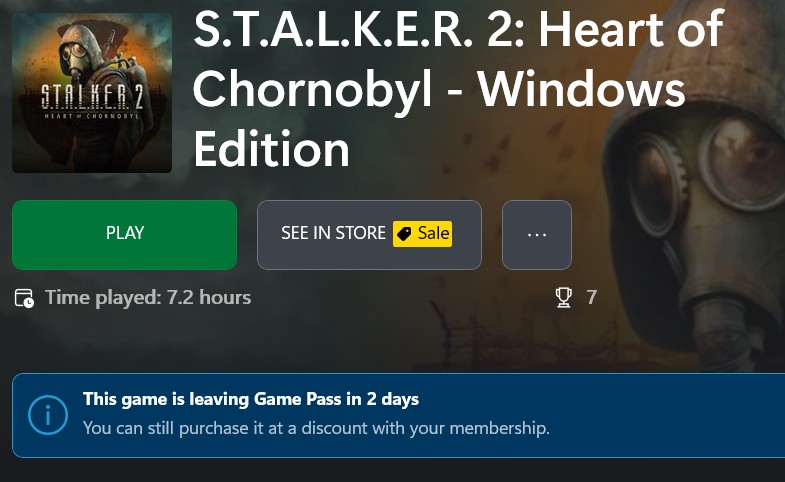
As the picture above shows, I did not get very far. I believe there was originally a 15-day warning message about the game leaving Game Pass, and so it was technically possible for me to plow through the 50ish hours needed to complete the game. However… it just didn’t grip me. Plus, I was trying to play some other games (Outer Worlds 2) at the time, so being “forced” into playing something else didn’t exactly leave me in the best headspace.
I have not talked about them much directly, but I have played all of the original games 10+ years ago:
- Stalker: Shadow of Chernobyl (22 hours)
- Stalker: Clear Skies (5.2 hours)
- Stalker: Call of Pripyat (22.7 hours)
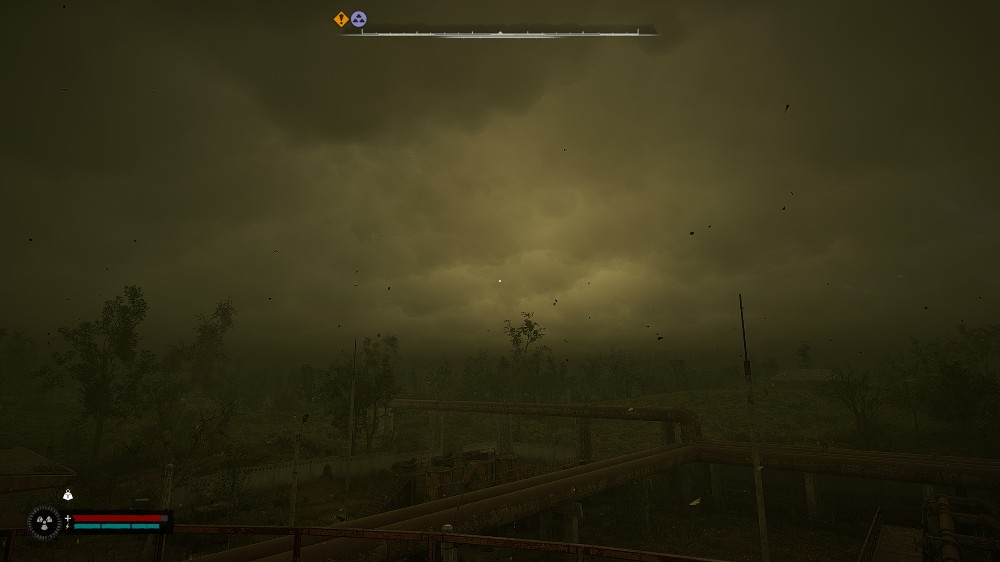
For those that have never played the series, Stalker is some quintessential eurojank. The premise (I think) is that after the Chernobyl nuclear disaster, the area is not just radiated, but a bunch of anomalies and mutants show up. The anomalies are extremely deadly environmental hazards that one must navigate carefully, but allow intrepid “stalkers” to claim nearby artifacts with varying powers. These are quite valuable scientific specimens, as you can imagine, leading many different factions fighting to control the best locations within the Exclusion Zone. There is also a loose plot that navigates you closer and closer towards the source of the anomalies.
One of the Stalker series’ biggest claims to fame is the “A-Life” mechanic. Essentially, A-Life was an attempt at making the Zone feel like a living, breathing world. We hear a lot about that sort of thing these days, usually with “innovations” like NPCs having a work schedule and going home at night, etc. Meanwhile, Stalker devs originally built NPCs capable of beating the game themselves back in like 2008. While things were reigned in a bit, the point is that a lot of very innovative stuff went on to make the original game world(s) feel like you were the least interesting thing in it… until you weren’t.
What does this all have to do with Stalker 2? Well, it originally launched without anything resembling A-Life. Instead, you got what every open-world game has: “dynamic” events that spawn randomly within rendering distance of you. Hearing gun shots in the distance while walking around can feel haunting; less so when it happens like clockwork. The more up-to-date articles I’m finding is saying that Stalker 2 eventually did get A-Life working, but some of the magic still feels gone.
Honestly though, that really just sort of sums it up: the magic is gone for me.

Graphics? Phenomenal. In the moment, things look a bit gritty and muddled. Then I realized that, hey, it kind of looks like I’m viewing this game through a body camera. That’s low-key crazy good.
The mutants are hit-or-miss. The dogs have insanely good AI, with all the juking and serpentine movement that causes immediate panic as you empty your magazine into the dirt and end up dying to what would otherwise be level 1 enemies in other games. Other mutants? Deadly… but rote. How nice of the invisible bloodsuckers to attack me, then run off long enough for me to use a healing injector and reload before attacking again.
My problem is that the series is just not that mechanically interesting to me anymore. Granted, maybe a whole lot of things change after hour 7, I dunno. Fundamentally though, there doesn’t seem to be a lot going on. For example, there are a lot of random abandoned houses dotting the landscape. You can go into just about every one of them. But… there’s nothing to interact with inside. While that “makes sense” from an immersion standpoint, it fails on a gameplay standpoint. Even when there are things to pick up, they’re just the same bullets, broken guns, canned meat, bandages, etc, as everywhere else. That leads you naturally to just going from map icon to map icon, collecting crap to sell to a vendor to hopefully afford something that the game is likely to just give you for free in another hour.
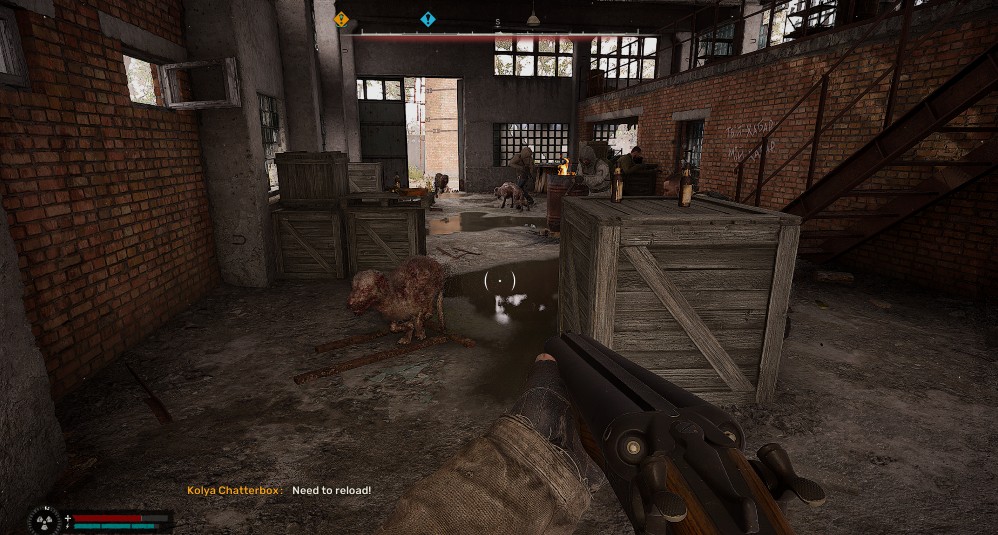
Seriously though, you start the game with a vest armor that provides about as much protection as, well, a regular-ass vest would. Then you talk with an NPC that can upgrade your vest with like chainmail for cash. Not two missions later though, you pick up a way better armor right at the start to an area, and then find an even better piece 30 minutes later. Gotta love these designer gotcha moments, right? Or hate them with an undying passion.
Meanwhile, the whole time I was playing, I was trying to remember what even happened in the first games. I thought I remembered there being a cool twist/choice at the end, then I realized I was thinking of Metro 2033’s ending instead. And by the way, Metro actually rewarded exploration because those extra bullets you found doubled as currency. To say nothing about Fallout 3, which came out at a similar time; even when not finding those little post-apoc vignettes, you were always looking for additional aluminum cans or duct tape.
Some of these criticism are, in a sense, unfair. Presuming that the A-Life situation is actually resolved, I would say that Stalker 2 is definitely a Stalker game. If you played the others, you’ll probably like it. There are some little things that add to the charm, like seeing a group of stalkers coming in an sitting around a campfire while someone plays the guitar. Or how after a firefight, the survivors actually loot the bodies of their comrades, just like you were about it. The first time that happened, I was like “Hey!” And then I was like, “fair play.”
So, if you’re in for a bleak, immersive mil-sim with some mutants and anomalies for flavor, then yeah. Stalker 2. (Un)Fortunately, I’ve been spoiled by Metro and Fallout in the intervening years, and it turns out I like what they bring more than what this series does. It’s a time and a place that’s passed for me.
Un-Necesse-ary
Necesse recently graduated from Early Access to full 1.0 release. I had played it previously for almost 10 hours, so I wanted to give it another go to see what had improved. As it turns out… not much.
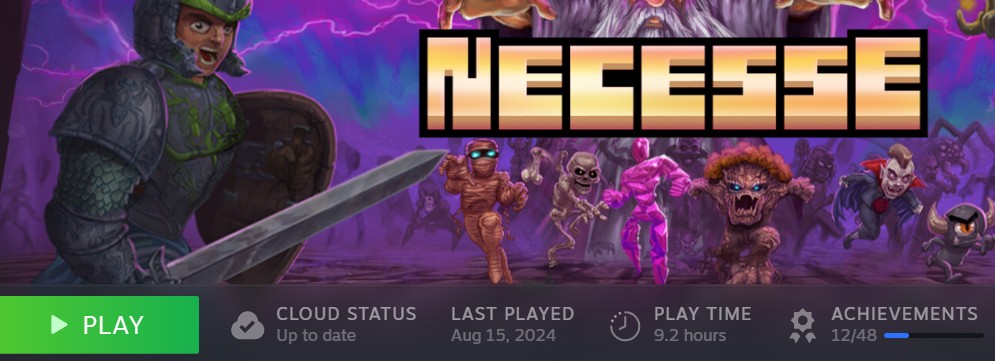
I’ve heard the game described as “top-down Terraria meets RimWorld,” but that is criminally misleading. Yes, it is a top-down, open-world survival crafting game with RimWorld-esque colony management functions. But what it’s actually more like is a lower-budget Keplerth. Now, in my Impressions of that game I called it a knockoff Necesse, so there’s some circular referencing going on.
The point is to not go into Necesse thinking you are going to get the same tight, engaging gameplay loops of Terraria or… like anything at all related to RimWorld’s subtle genius. The NPCs you recruit to your village can be assigned tasks like chopping wood or shearing sheep, but they have zero personality, relevant moods, or any necessary functionality at all. Hell, most of the crafting you can do is itself pointless in comparison to random drops.
OK, let’s back up. What’s Necesse and its gameplay loop?
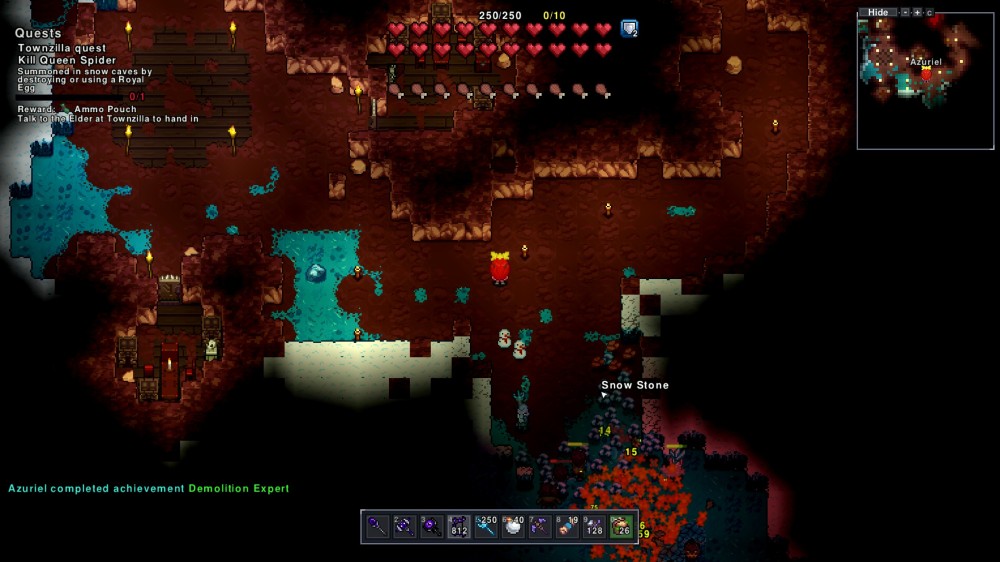
In Necesse, there is a large overworld with various creatures and hazards and biomes to explore. Additionally, there is an underground “layer” full of much more dangerous monsters and random loot. The loose goal is for you to summon bosses using specific item drops, defeat them, and use the resulting drops to unlock the next tier of progression. As you might expect with the top-down perspective, most of the bosses are bullet-hell style affairs with multiple phases.
There is crafting in Necesse, but it feels largely perfunctory and unsatisfactory. Yes, you can collect wood to make a Wood Sword, smelt copper into copper ingots to make a Copper Sword, and so on. You can also just buy weapons from NPCs too, skipping multiple tiers in the process. Indeed, the underground portions of the game feature loads of enemies that have a chance of dropping gear that vastly outstrips anything you could reasonably craft. So, rather than feeling like you are earning your way through escalating challenges, most of the time you are better off just running around under-geared until you very suddenly are not.
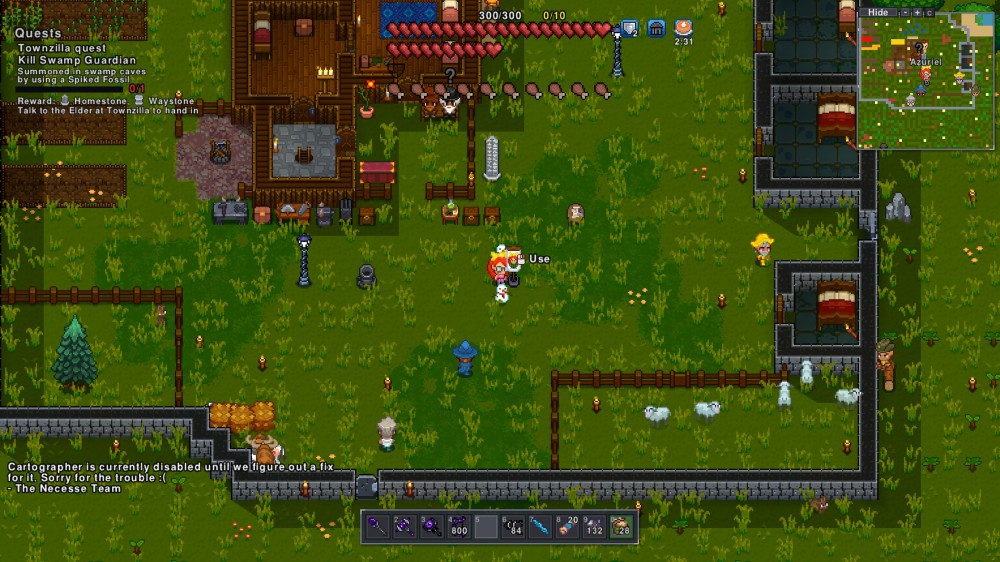
There is technically hunger in Necesse, but it is the sort of half-baked nonsense that is unfortunately typical in this space. Are there dozens of food recipes? Yes. Are any of them necessary at all? No. More complicated dishes can grant you larger bonuses to damage (etc) and you can even automate some of the cooking via the NPCs you recruit to your base. But… why? Just eat a bunch of coconuts or berries or whatever else is nearby. Perhaps this sort of thing becomes more required on higher difficulties. It all just feels rote, like designers going through the same motions just because “everyone” builds games this way. It’s 2025, guys: if food isn’t going to be super-scarce resource, then it needs to have a more integrated game function (increasing HP, etc) ala Valheim or similar. Otherwise, just leave it out.
To an extent, it’s a bit unfair to be too harsh on Necesse considering it was largely developed by one dude. Counter-point: Stardew Valley. Also: maybe it’s worth bringing on more people to make the game more engaging? There was a graphics overhaul at one point, which certainly improved things, but the UI itself is still hot garbage. Could they make the icons even tinier? [Fake Edit:] Just found the option for UI scale, but it still looks bad even when scaled up.
Anyway, that’s Necesse.
Never the Straw You Want
I may be done with Hearthstone for good. At the very least, it has been more than a month since I last logged in. While my participation has ebbed and flowed over the last twelve (12!) years I have played, this time feels a bit different. I just… have no specific desire to log in again. The impetus is gone.
And I’m pretty sure it’s because of the Event quest changes.
When we talk about the “straw that broke the camel’s back,” we refer to a number of isolated causes that, over time, accumulate to the point of sudden failure. But what is often not addressed, is how… lame the very last one can be. I didn’t stop playing because of some Blizzard controversy (remember Hong Kong?), or reintroducing mechanics that the devs hate and whom consequently made bad on purpose, or leveraging terrible AI artwork in promotional material, or making sets intentionally weak as a power level reset while still charging full price, or introducing $158 pet gacha mechanics, or any of the multitude of other reasons. Hell, I didn’t even quit over the first disastrous quest overhaul.
Nah, the last straw for me was Blizzard getting too cute with the Event quests.
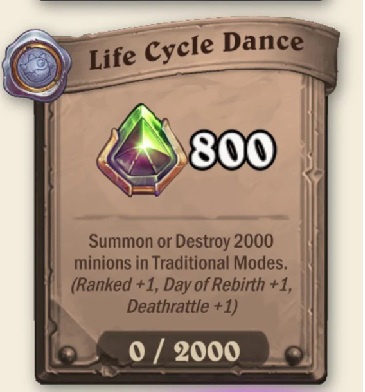
For context, Event Quests are an extra layer of Weekly/Daily quests that grant Event XP that moves you along a reward track. These Events last 4-5 weeks or so, and the rewards are usually free packs, hero portraits, and occasionally free epic/Legendary cards. Blizzard has actually stepped up the number of Events lately – or at least it felt that way – so in many respects, I should have been feeling grateful for the extra stuff. Instead, I felt worse.
Thing is, I used to be able to complete quests, including Event quests, while doing Battlegrounds. This was helpful for those time periods in which Standard was feeling boring, or perhaps I didn’t have all the Legendaries needed for a competitive deck, or just enjoyed Battlegrounds more at that time. These new quests have the “Traditional Modes” limiter, which means Standard or Wild only.
Also, I don’t know if you know this about me, but I’m something of an optimizer. If you tell me I need to either play 2000 minions OR 500 Day of Rebirth deathrattle minions in Ranked Standard, I’m going to try the latter. And it’s going to feel horrible, not the least because any deck filled with those specific kind of minions is going to lose, on account of them being non-competitive. So here I am, trashing my Rank by losing constantly with cards I barely get to play – as games don’t last long when you play bad cards – and I still have to play like 500 of them, all because some fucking black-hat psychologist thought it would maximize engagement. Fuck every bit of that.
“Just ignore the quest and play normally.” Hearthstone isn’t the only game I play, and I sometimes go days without playing at all. Without focusing specifically on completing the quest, including the specific game modes it requires, completion won’t actually happen naturally. “Events aren’t required for anything, just enjoy whatever rewards you can get at your level of engagement.” Missing rewards, which now sometimes includes Legendary cards in the final steps, feels worse than not having Events happening at all. It would be one thing if it were a hidden achievement, or unlocked just a new skin or whatever, but it’s a rather in-your-face tracking mechanism that pops up after every game.
It’s a straw. Individually immaterial. Completely harmless to anyone who still enjoys playing Hearthstone on a baseline level. I 100% recognize that, by all measures, I would have likely drifted further and further away from the game independent of any changes to Event quests or otherwise.
However… it’s the last fucking straw. Perhaps not the one I deserve, but the one I have right now.
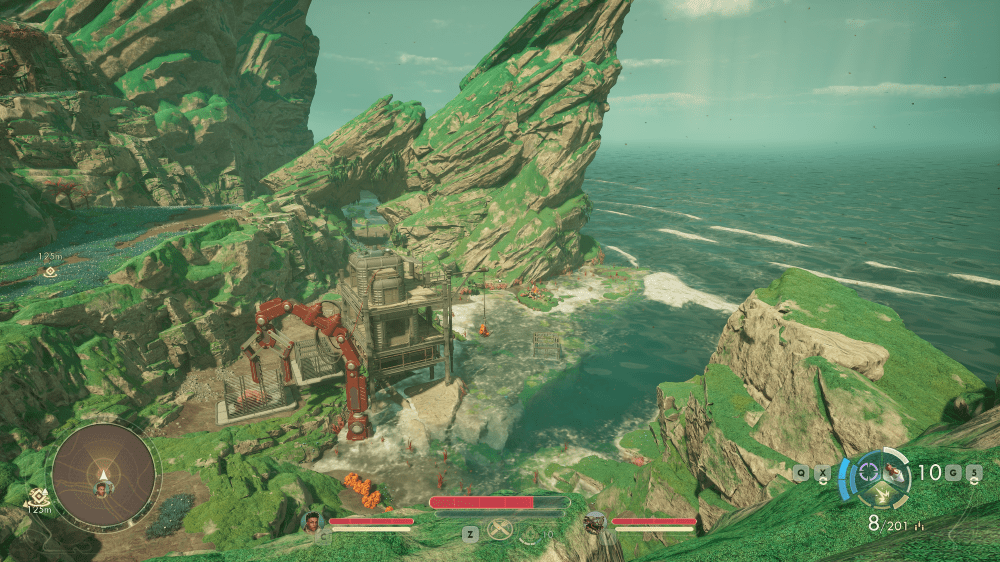
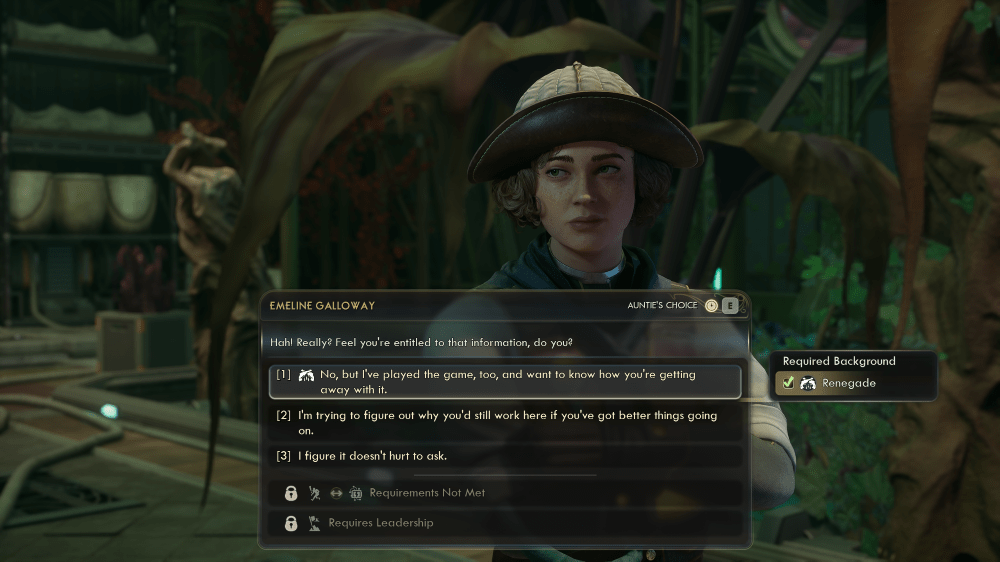
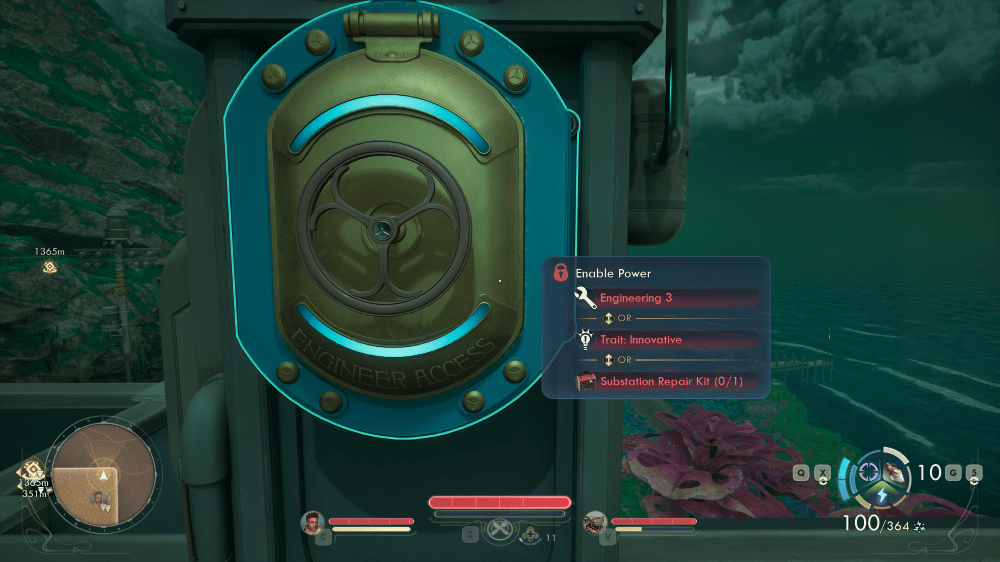
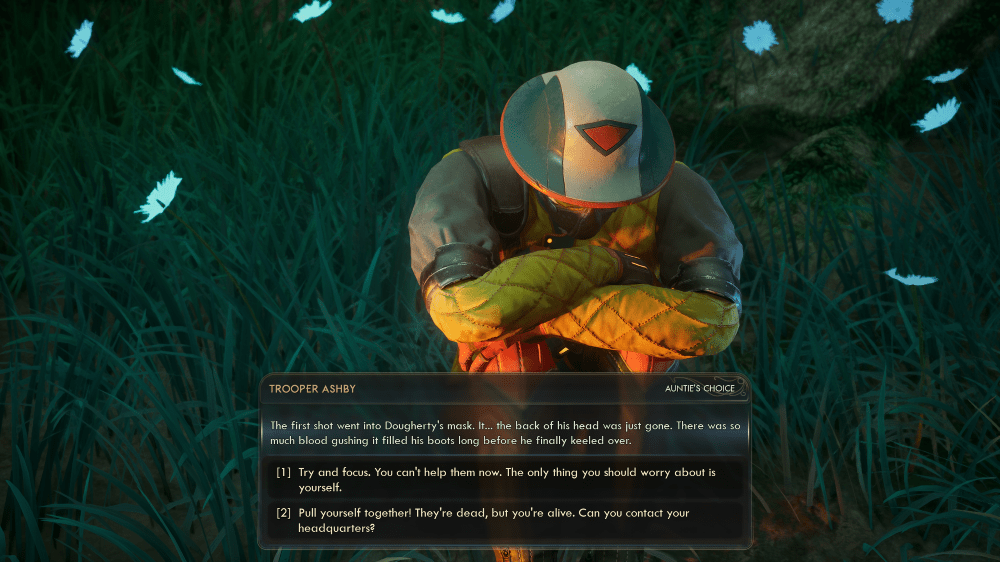
“Normal People Don’t Care”
Dec 18
Posted by Azuriel
There is a minor, ongoing media kerfuffle with the internet-darling Larian Studios (makers of Baldur’s Gate 3, Original Sin 2, etc). It started with this Bloomberg article, wherein Jason Schreier writes:
There are possible charitable and a not-so-chartable takes on those words, and suffice it to say, many people chose the latter. Vincke responded with a “Holy fuck guys [chill out]” Twitter response, with clarifications and emphasis that they only use AI for reference material and other boring things, and not with actual content. Jason Schreier also chimed in with an original transcript of the interview, as a response to others suggesting that what Schreier wrote was itself misleading.
As a side note, this portion of the transcript was extra interesting to me:
I suppose I should take Vincke’s word on the matter, considering how he released a critically-acclaimed game that sold 20 million copies, and I have… not. But, dead? Larian Studios has over 500 employees at this point, so things are likely different at these larger scales. I’m just saying the folks that made, you know, Silksong or Megabonk are probably going to be fine without pushing AI into their processes.
Anyway, all of that is actually a preamble to what sent me to this keyboard in the first place. In the Reddit comments of the second Schreier piece, this exchange took place:
do not engage… do not engage… do not engage…
Guys, it’s hard out here in 2025. And I’m kinda all done. Tapped out. Because SexyJazzCat is correct.
Normal people don’t actually care. We know this because “normal” people voted the current administration back into office. Normal people don’t understand that measles can reset your immune system, erasing all your hard-fought natural immunities. Normal people don’t understand that every AI data center that springs up in your area is subsidized by increases to your own electric bill. Normal people don’t understand that tariffs are taxes that they end up paying for. Normal people don’t understand that even if they didn’t use ACA subsidies, their health insurance is going to wildly increase anyway because hospitals won’t be reimbursed for emergency care from newly uninsured people. Nevermind the, you know, general human misery this creates.
Normal people don’t actually care about AI. But they should. Or perhaps should have, past tense, because we’re far past the end of a very slippery slope and fully airborne. Normal people are just going to be confused as to why computers, phones, and/or videogame consoles are wildly more expensive in 2026 (e.g. RAM crisis). Or if AI successfully demonstrates real efficiency gains, surprised when they are out of a job. Or if AI crashes and burns, why they also still lost their job and their 401k cratered (e.g. 40% of S&P 500 value is in AI companies).
The only thing that I still wish for these days, is this: people have the kind of day they voted for.
Posted in Commentary
3 Comments
Tags: AI, Capitalist Dystopian Hellscape, Jason Schreier, Larian, Normal People, Reddit